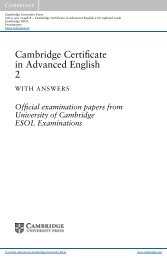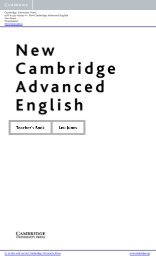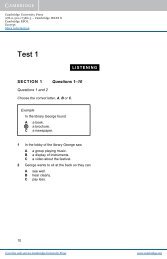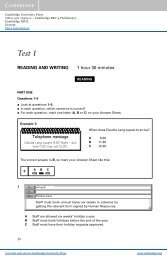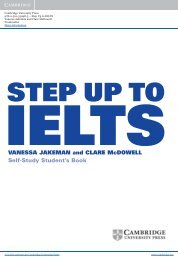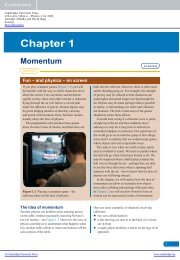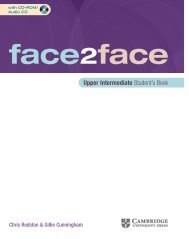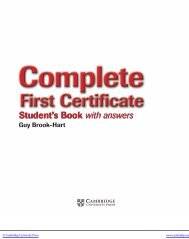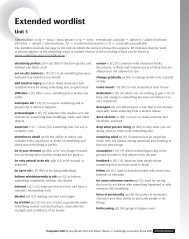Passage 3aStudies of acupuncture all show that women like to visit acupuncturists more thanmen (<strong>for</strong> instance Macpherson et al., 2006; Thomas et al., 1988). This is becausewomen always visit doctors more than men. The survey shows that the majority ofpeople going to acupuncturists are between the ages of 35 and 70. Clearly, this isbecause everybody develops health problems as they get older, so they need to visitthe doctor more often.bSeveral recent studies of patients’ reasons <strong>for</strong> visiting acupuncturists indicate thatwomen tend to visit acupuncturists more than men (<strong>for</strong> instance Macpherson et al.,2006; Thomas et al., 1988). One possible reason <strong>for</strong> this is that women tend to visitdoctors of all types more often than men do. Another finding of the survey is that themajority of people visiting acupuncturists are between the ages of 35 and 70. Thismay have something to do with increased health problems in this age group.4 Protecting your position through citation4aSuggested answers1 Probably the first sentence: this is a non-integral citation (outside thesentence) and there<strong>for</strong>e suggests that the writer has accepted Jones’s claimas fact.2 Probably the second sentence: the writer has used ‘according to Jones’,which is more ambivalent about Jones’s claim than the citations given insentences 1 or 3.The position of the citation in sentence c along with the reporting verb ‘notes’clearly implies that the author wishes to present the in<strong>for</strong>mation as a viewbelonging to Jones. In contrast, the non-integrated citation at the end of thesentence suggests that the author wishes to present the in<strong>for</strong>mation as fact.4bSuggested answers1 (C) – Non-integral citations tend to accompany statements of what the authoraccepts as fact.2 (D) – Integral citation shows the writer’s stance with the expression used <strong>for</strong>the citation. In this case ‘according to’ implies that the author may not agreewith the source, or is leaving room <strong>for</strong> doubt.3 (C) – Integral citation with the phrase ‘have proved that’, which seems toimply certainty.4 (D) – Integral citation, using the word ‘claims’ which may imply that the authordoes not agree with the source / leaves room <strong>for</strong> doubt.4cAnswers1Note: In this passage, most of the citations are non-integral (outside the grammar ofthe sentence) so only one has an introductory sentence.Unit 3 Part C ∙ Investigating 90
Herbal medicines are used widely within the UK (Benson et al., 2009). Indeed, asa recent study by Cox (2008) indicates, rising annual sales of herbal medicinessuggest that their popularity is on the increase. This popularity is probablydue to a number of factors: low price compared to the costs of conventionaldrugs (Cox, ibid); a popular notion that herbal treatments have fewer sideeffects (Lasky et al., 2005); and a growing interest in spiritual, traditional or‘holistic’ approaches to staying healthy which are not typically offered in themainstream medical system (Campbell & Ho, 2008). It seems, then, that peopleturn to herbal medicines and other similar treatments both because of typicalconsumer behaviour (sensitivity to cost and comparison of different products)as well as a rising attraction to ‘alternative’ lifestyle choices in the UK at large.2According to Quinn (2008), approximately 35% of the UK population willuse herbal remedies of some sort during their lifetime, either by visiting aherbal practitioner or by purchasing over-the-counter remedies in a shop.Numerous explanations have been given <strong>for</strong> the apparent popularity of theseremedies. Cox (2008) notes that the costs of herbal remedies are often farlower than conventional drugs (both in terms of monetary cost, and the timespent visiting a doctor to receive a prescription). However, there may be otherfactors involved besides cost. According to Fuller (1999), herbal remedieshave far fewer side effects than mainstream treatments. One study by Ponzioand Stewart (2004) suggests that this benign view of herbal medicines iswidespread among the general public, who may there<strong>for</strong>e be more inclined tochoose herbal medicines to treat less serious conditions. A further possibility<strong>for</strong> the widespread reliance on herbal medicines is suggested by Campbelland Ho (2008), who claim that herbal medicines fit in with a growing interest in‘alternative’ lifestyle choices in the UK. There is a growing interest in spirituality,alternative philosophies and fascination with ancient healing systems fromother nations such as India and China, and herbalism naturally falls into thatcategory of lifestyle choices.4dSuggested answers1 In 1) the writer seems more certain about the in<strong>for</strong>mation they have used,because they use non-integral citations throughout, implying agreement. In 2)the author has used integral citations and more cautious phrases to introducethe in<strong>for</strong>mation.2 Certain, because of the non-integral citation.3 This depends on the student. It is hard to say whether it is justified becauseno supporting evidence is presented. A reader could justly question whetherthe supporting sources were correct. (However, it might be worth pointingout that this type of unquestioned integral citation is more common – andappropriate – in the introductory section of an essay / report than it would bein a discussion section, <strong>for</strong> instance.) The use of more cautious language, andsupporting evidence, would help to make this more persuasive.Unit 3 Part C ∙ Investigating 91
- Page 1 and 2:
Skillsfor StudyLEVEL 2Teacher’s N
- Page 3 and 4:
IntroductionThe Skills and Language
- Page 5 and 6:
Introductioncases, even in texts wh
- Page 7 and 8:
Unit 1Gender issuesUnit OverviewPar
- Page 9 and 10:
Women are oftenenrolled on lesspres
- Page 11 and 12:
2b Students take turns presenting t
- Page 13 and 14:
Note: There is a deliberate flaw in
- Page 16 and 17:
Passage cGender gap in higher educa
- Page 18 and 19:
3dAnswersThe correct readings are:F
- Page 20 and 21:
Unit Task: The gender gap1 Students
- Page 22 and 23:
1fAnswersFaiola, A. (2008, May 16).
- Page 24 and 25:
Copy information directlyfrom a lab
- Page 26 and 27:
European Commission. (2009). She Fi
- Page 28 and 29:
2cSuggested answersAccording to Fig
- Page 30 and 31:
Suggested answersGraphic Strengths
- Page 32 and 33:
Suggested answersFeatureStructures
- Page 34 and 35:
Quite separately from the issue of
- Page 36 and 37:
5b Group discussion5c Students inve
- Page 38 and 39:
Unit 2WaterPart AUnderstanding spok
- Page 40 and 41: 1jAnswersYes, I agreeOn top of that
- Page 42 and 43: Assignment 1aAnswersArid: A very dr
- Page 44 and 45: Assignment 2Note: The unit task for
- Page 46 and 47: 1c Group discussion1dSuggested answ
- Page 48 and 49: 3dSuggested answers1 To determine w
- Page 50 and 51: Part CInvestigatingThe aim of this
- Page 52 and 53: 3aSuggested answersList all the pos
- Page 54 and 55: 4bSuggested answers1 introductory s
- Page 56 and 57: 4hSuggested answerProbably not real
- Page 58 and 59: Part DReporting in speechThe aim of
- Page 60 and 61: 4bSuggested answersYou want to go b
- Page 62 and 63: Part EReporting in writingThe aim o
- Page 64 and 65: 2cSuggested answersDetermining the
- Page 66 and 67: 3gExample of the rewritten sectionE
- Page 68 and 69: BDiscussionFlow rate increases with
- Page 70 and 71: Suggested answers1Feasibility repor
- Page 72 and 73: water sources is that considerable
- Page 74 and 75: we therefore recommend that the com
- Page 76 and 77: Unit 3ProgressPart AUnderstanding s
- Page 78 and 79: 4b See 4c for answers.4cAnswers3.5S
- Page 80 and 81: Unit Task: Traditional, complementa
- Page 82 and 83: 2dAnswersBeginning / ending of a se
- Page 84 and 85: 4bAnswersDate Test subjects Effects
- Page 86 and 87: Part CInvestigatingThe aim of this
- Page 88 and 89: 2bSuggested answers• Only a littl
- Page 92 and 93: 4eSuggested answers1Presents factua
- Page 94 and 95: One study by the WHO indicates that
- Page 96 and 97: Part DReporting in speechThe aim of
- Page 98 and 99: Unit Task: Traditional, complementa
- Page 100 and 101: 1gSuggested answersSource A (Kirkup
- Page 102 and 103: Source B: Cohen, 2009.Paragraph Mai
- Page 104 and 105: So far I have successfully complete
- Page 106 and 107: Unit 4Art, creativity and designPar
- Page 108 and 109: 4.23aSuggested answers1 The survey
- Page 110 and 111: defStudents listen again to judge t
- Page 112 and 113: Note: In the next series of activit
- Page 114 and 115: 2hAnswersDefinition of contrapposto
- Page 116 and 117: 3 Reading critically3aAnswersAbilit
- Page 118 and 119: Dürer’s 1495 drawing is of class
- Page 120 and 121: To summarize, art and architecture
- Page 122 and 123: 2 Analyzing the suitability of samp
- Page 124 and 125: Part DReporting in speechThe aim of
- Page 126 and 127: 2fAnswers1 Speaker 1 gives an expli
- Page 128 and 129: 1c Note: As this activity depends t
- Page 130 and 131: Example research proposal abstract
- Page 132 and 133: 2iExample abstractFeatures of the p
- Page 134: The terms ‘Harvard style’, ‘H



